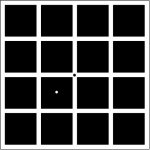- Jul 30, 2007
- 8,369
- 68
- 0
- School/Org
- Newsbot U
- City
- Barre
- State
- VT
Backward Masking and Unmasking Across Saccadic Eye Movements. Curr Biol. 2010 Mar 24; Authors: De Pisapia N, Kaunitz L, Melcher D Humans make several eye movements every second, and thus a fundamental challenge in conscious vision is to maintain continuity by matching object representations in constantly shifting retinal coordinates [1]. One possible mechanism for visual stability is the remapping of receptive fields around saccade onset, combining pre- and postsaccadic information [2]. The mislocalization of stimuli briefly flashed near the time of saccades [3-7] has been taken as evidence for remapping. Yet the relationship between remapping, mislocalization, and trans-saccadic integration remains unclear. We asked participants to identify a target stimulus presented around the time of saccade onset, which was immediately visually masked by a postsaccadic stimulus presented in the same spatial location (backward masking). Presenting two rapidly occurring events across separate fixations allowed us to investigate how the visual system reconstructs what happens during a saccade. We show that saccadic remapping resulted in perception of target and mask as either spatially segregated or integrated, depending on the exact timing of saccade onset. During segregation, the target was unmasked because it was perceived as displaced from the mask; during integration, the postsaccadic stimulus masked the presaccadic target (spatiotopic masking). Thus, segregation and integration may work together to yield continuity in conscious vision. PMID: 20346671 [PubMed - as supplied by publisher]
More...
More...





